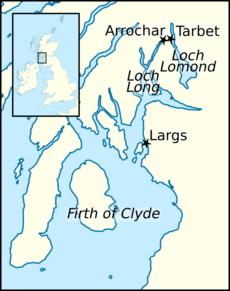Aonghus Mór facts for kids
Quick facts for kids
Aonghus Mór mac Domhnaill
|
|
|---|---|
| Lord of Islay | |
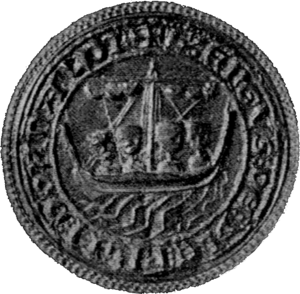
The seal of Aonghus Mór.
|
|
| Successor | Alasdair Óg Mac Domhnaill |
| Died | c. 1293 |
| Noble family | Clann Domhnaill |
| Issue | Alasdair Óg, Aonghus Óg, Eóin Sprangach |
| Father | Domhnall mac Raghnaill |
Aonghus Mór mac Domhnaill (who died around 1293) was an important leader in the 1200s. He lived in the Kingdom of the Isles and Kingdom of Scotland. He was the son of Domhnall mac Raghnaill. Domhnall was the founder of Clann Domhnaill, a powerful family group. This family was part of a larger group called Clann Somhairle. Aonghus Mór likely became the leader of his family in the mid-1200s, after his father.
Back then, the rulers of the Isles were very independent from the King of Scotland. They mostly answered to the King of Norway, who was far away. Aonghus Mór first appears in history helping Irish families. These families were fighting against English and Irish lords who were taking over land in north-west Ireland. Clann Domhnaill might have made these alliances to get help against Scottish attacks.
In 1263, the Scottish king attacked the Isles. This led the Norwegian king to start a war against Scotland. Aonghus Mór supported Norway, like other leaders from Clann Somhairle. But the Norwegian king had to force Aonghus Mór to join. This suggests Aonghus Mór didn't want to help much. The Norwegian plan failed. The Islesmen had to surrender to Scotland after more fighting in 1264. Aonghus Mór had to give his son, probably Alasdair Óg, as a hostage to the Scottish king. By 1266, Scotland officially took control of the Isles.
In the years that followed, Aonghus Mór and his relatives became part of the Scottish kingdom. For example, Aonghus Mór attended a big government meeting in Scone in 1284. At this meeting, Margaret, Maid of Norway, the granddaughter of King Alexander III, was named the rightful heir to the throne. After King Alexander III died suddenly in 1286, Aonghus Mór and Alasdair Óg signed the Turnberry Band. This was an agreement between several Scottish and Anglo-Irish lords. It might have been about continuing to fight against Anglo-Irish rule in north-west Ireland. Aonghus Mór died around 1293. His son, Alasdair Óg, became the new Lord of Islay. Aonghus Mór was married to a woman from the Caimbéalaigh family (the Campbells). Besides Alasdair Óg, he had two other sons, Aonghus Óg and Eóin Sprangach. He also had two daughters who married important men.
Contents
Aonghus Mór's Family and Connections
Aonghus Mór was the son of Domhnall mac Raghnaill. Domhnall was the person who gave the Clann Domhnaill family its name. Because of this, Aonghus Mór can be seen as the first "Mac Domhnaill." Clann Domhnaill was the youngest of three main branches of Clann Somhairle. The other two branches were Clann Dubhghaill and Clann Ruaidhrí. These families were descended from Domhnall's uncle and older brother. Old stories from the 1700s say that Aonghus Mór was raised by the family that founded Clann Duibhshíthe. We don't know exactly when Domhnall died or when Aonghus Mór took over. But Aonghus Mór was clearly leading the family by the 1260s. This suggests his father had died or retired by then.

Aonghus Mór married a woman from the Caimbéalaigh family (the Campbells). According to a history from the 1600s, she was the daughter of Cailéan Mór Caimbéal. He was a very important member of the Campbell family. She was also the mother of Aonghus Mór's younger son, Aonghus Óg. Aonghus Mór named his first son, Alasdair Óg, after King Alexander III of Scotland. This shows how Scottish influence was spreading in the Isles. It might also mean the family was trying to get closer to the Scottish king.
One of Aonghus Mór's daughters married Domhnall Óg Ó Domhnaill, the King of Tír Chonaill in Ireland. Another daughter married Hugh Bisset. Alasdair Óg was the ancestor of several important gallowglass (a type of warrior) families in Ireland. He also founded the Clann Alasdair branch of Clann Domhnaill. Another son, Eóin Sprangach, was the ancestor of the Ardnamurchan branch of Clann Domhnaill. There is also some evidence that Aonghus Mór might have had another son named Domhnall of Islay.
Early Life and Actions

We don't know much about Aonghus Mór's early life. We know even less about his father's life. One old book, the Chronicle of Mann, might tell us something. It says that an old chief named "Dofnaldus" was highly respected by Haraldr Óláfsson, King of Mann and the Isles. But after Haraldr died, and his brother was killed, a rival took the throne. This rival then imprisoned Dofnaldus and his baby son. The story says Dofnaldus and his son escaped with God's help. The person who wrote the chronicle said Dofnaldus told him the story himself. It's possible that Dofnaldus and his son were Domhnall and Aonghus Mór.
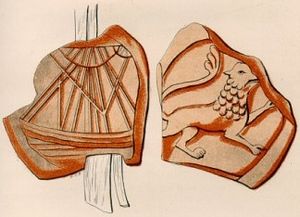
Aonghus Mór also gave some land to the Paisley Abbey monastery. One gift was money and a promise to protect the monks. This was similar to a gift made by his grandfather, Raghnall mac Somhairle. Aonghus Mór also gave the church of St Ciarán in Kintyre to the monastery. This gift mentions a king and prince named Alexander. This could mean King Alexander II and his son Alexander III. If so, the gift happened between 1241 and 1249. Or it could mean Alexander III and his son Alexander. If so, it happened between 1264 and 1284. The gift says it was made "for the welfare of my lord Alexander, illustrious king of Scots." This might show Aonghus Mór trying to get closer to the Scottish king.
Aonghus Mór and Irish Affairs
The first clear record of Aonghus Mór is from February 1256. The English king ordered that he and other men from Scotland should not be allowed into Ireland. In the mid-1200s, important members of Clann Somhairle were involved in Irish politics. In 1247, a man from the Mac Somhairle family was killed fighting an English invasion in Tír Chonaill. In 1258, Dubhghall raided western Ireland and killed an English sheriff. The next year, a daughter of Dubhghall married Aedh mac Felim Ó Conchobair. She brought 160 gallowglass warriors, led by Dubhghall's brother, Ailéan mac Ruaidhrí.
In 1259, Aodh na nGall and other Irish leaders gave up their claims to be High-King of Ireland. They chose Brian Ó Néill, King of Tír Eoghain, who wanted to fight the Anglo-Irish in Ulster. But their combined forces were completely defeated by the Anglo-Irish at the Battle of Druim Dearg in 1260. Brian was killed in the battle.
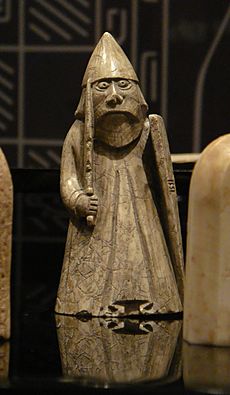
The Uí Conchobhair family clearly got military help from the Isles, specifically from Clann Ruaidhrí. It seems the Cineál Chonaill family also had ties with Clann Domhnaill. Aonghus Mór's daughter married Domhnall Óg Ó Domhnaill, the King of Tír Chonaill. Their son, Toirdhealbhach Ó Domhnaill, took the kingship of Tír Chonaill from his half-brother in 1290. He did this with military help from Clann Domhnaill. If Aonghus Mór was involved with Brian Ó Néill's uprising, that could explain why the English king singled him out in 1256. The English might have seen alliances between Irish and Islesmen as a threat to the king.
These alliances might have been made to fight both the English in Ireland and the Scottish king's growing power. In the 1230s and 1240s, Scotland tried to expand its rule into Argyll and the Isles. For example, the king gave the rights to the church of Killean to the Diocese of Argyll. This church had been under the protection of Aonghus Mór's uncle, Ruaidhrí. Aonghus Mór probably thought he had the right to protect it.
A Norwegian Subject

Clann Somhairle and the Isles Kingship
In 1248, two important members of Clann Somhairle traveled to Norway. They wanted to become king of the northern Isles from Hákon Hákonarson, King of Norway. These two were Eóghan Mac Dubhghaill and Dubhghall mac Ruaidhrí. They were chiefs of Clann Dubhghaill and Clann Ruaidhrí. The Isles included the Hebrides and the Isle of Man. It's not clear exactly which part of the Isles they wanted to rule.
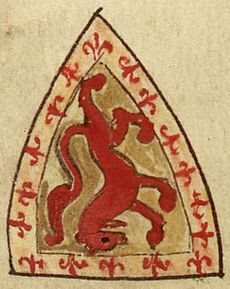
After Haraldr Óláfsson died in 1248, King Hákon sent Eóghan to rule the Isles for a short time. But Eóghan was also an important Scottish lord. Scotland had tried to buy the Isles earlier. Eóghan accepting Hákon's offer led King Alexander II to invade Argyll in 1249. This attack was aimed at the heart of Clann Dubhghaill's land. The crisis ended when the Scottish king died suddenly in July 1249. The first clear mention of Aonghus Mór in records is from the year after Eóghan finally sided with the Scottish king.
Scotland Attacks, Norway Responds
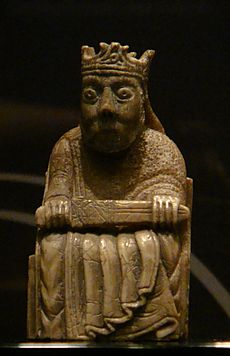
About ten years after Alexander II died, his son, Alexander III, became an adult. He decided to continue his father's plan to expand west. In 1261, Scotland offered to buy the Isles from Norway. When Norway refused, the Scots attacked the people of Skye very cruelly. In 1262, after another failed attempt to buy the Hebrides, the Hákonar saga Hákonarsonar says the Scots again attacked Skye.
Because of this, King Hákon gathered a huge fleet of ships. Old Icelandic records say it was the largest force ever to sail from Norway. He wanted to show that Norway still ruled the coasts of Scotland. In July 1263, this fleet left Norway. By mid-August, Hákon had control of Shetland and Orkney. He also forced Caithness to surrender and arrived in the Hebrides.
The Hákonar saga Hákonarsonar says that Magnús Óláfsson, King of Mann and the Isles and Dubhghall met Hákon there. As the fleet sailed south, Hákon sent some ships to attack Kintyre. These ships were led by Dubhghall and Magnús Óláfsson. Hákon himself landed on Gigha. Magnús Óláfsson and Dubhghall were supposed to get Aonghus Mór and Murchadh Mac Suibhne to join the king. The saga says that the attacks on Kintyre finally made Aonghus Mór and Murchadh surrender to Hákon. They swore loyalty, gave hostages, and handed over the island of Islay. The king also demanded a tax of one thousand cattle from Kintyre. A fortress, probably Dunaverty Castle, was also given to Hákon.
In early September, Hákon's fleet entered the Firth of Clyde. After talks between Scotland and Norway failed, Magnús Óláfsson, Dubhghall, Ailéan (Dubhghall's brother), Aonghus Mór, and Murchadh led a group of Islesmen and Norwegians. They went into Loch Long, carried their ships over land into Loch Lomond, and attacked the area around the Lennox. This group had forty or sixty ships, a large part of Hákon's fleet. They were likely attacking the lands of the powerful Stewart kindred.
Meanwhile, in early October, Hákon's main force fought the Scots at Largs. Then they went back to the Hebrides. Once they met up with the Islesmen, Hákon rewarded his supporters. Since Eóghan had refused to help Norway, Dubhghall and Ailéan were given his islands. A man named Ruðri received Bute, and Murchadh got Arran. Aonghus Mór already owned Islay, so he wasn't listed as getting new land.
The saga says Norway won a great victory, but it seems the campaign actually failed. Hákon didn't break Scotland's power. Instead, King Alexander III attacked the Isles and northern Scotland the next year. Magnús Óláfsson surrendered to Alexander III within a year. This showed that Norway had completely lost control of the Isles.
The Scots' attack on the Isles was led by Alexander Comyn, Earl of Buchan, Uilleam, Earl of Mar, and Alan Hostarius. Old records say these lords attacked the islands. This is supported by another record that says Scottish forces invaded the Isles and forced Aonghus Mór and others to surrender. There is also evidence that Walter Stewart, Earl of Menteith gathered a royal fleet.

Despite these attacks, Scotland only partly succeeded in getting Clann Somhairle to join them. Dubhghall still refused to accept Scottish rule. But in 1266, almost three years after Hákon's failed campaign, Scotland and Norway finally made peace. The Treaty of Perth was signed in July. Hákon's son, Magnús Hákonarson, King of Norway, officially gave up all rights to Mann and the islands off Scotland's west coast. This finally settled the land dispute.
A Scottish Subject
Joining Alexander III's Kingdom
After Norway left and Scotland took over the Isles, Aonghus Mór had to surrender to the Scots. He was forced to give his son, probably Alasdair Óg, as a hostage. His son was held at Ayr to ensure Aonghus Mór behaved well. The fact that his son had a nurse suggests he was a young child. Aonghus Mór formally agreed that he would lose his lands if he was disloyal to the Scottish king again. Other lords in Argyll swore to fight him if he broke his promise.
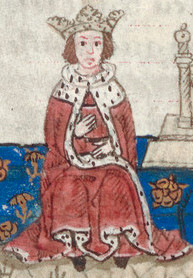
Lords from the west, like those from Clann Somhairle, rarely visited the Scottish royal court. But sometimes they took part in important government matters. For example, in 1284, Aonghus Mór attended a council in Scone. This council recognized King Alexander III's granddaughter, Margaret, Maid of Norway, as the rightful heir. Aonghus Mór and three of his relatives from Clann Somhairle were there. This shows how the family was becoming part of the Scottish kingdom.
Political Groups After Alexander III's Death
Clann Somhairle families also formed alliances with different political groups in Scotland. Clann Dubhghaill joined the powerful Comyn kindred. Clann Domhnaill sided with the Bruce kindred. This partnership likely happened after King Alexander III died unexpectedly in March 1286. Even though Margaret had been named heir, two main groups claimed the throne. In April, Robert Bruce V, Lord of Annandale announced his claim. John Balliol, supported by the Comyns, also claimed the throne.

The Bruce group might have thought their claim was weaker than the Comyn-Balliol group's. In September, members of the Bruce group made an agreement called the Turnberry Band. In this pact, Scottish and Anglo-Irish lords, including Aonghus Mór and his son Alasdair Óg, promised to support each other. The exact purpose of the pact is unclear. It might have been linked to the Bruce claim to the throne. The Scottish lords promised to support two important Anglo-Irish lords: Richard de Burgh, Earl of Ulster and Thomas de Clare, Lord of Thomond.
One goal of the pact might have been to help Richard and Thomas in north-west Ireland. It could have helped Thomas get control of his northern lands from his rival and from local Irish families. So, part of the pact might have been to limit Clann Domhnaill's connections with Irish families who opposed the earl. The pact happened at the same time as a huge show of force by Richard in Ireland. He took hostages from Irish families and removed a king from power. The Anglo-Irish signers of the pact might have wanted naval support from Clann Domhnaill. Aonghus Mór might have helped with the earl's actions.
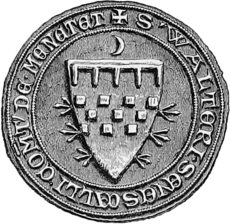
The Bruce and Stewart families also had interests in north-west Ireland. The Stewart family later claimed lands that had belonged to John Balliol's ancestors. The Stewart family's involvement in the pact might also have been about their role in taking over the Clann Suibhne lands in Argyll. Clann Suibhne was forced out of Scotland. They found safety in Tír Chonaill because of an alliance with Domhnall Óg. Domhnall Óg's son was related to Clann Suibhne, and Domhnall Óg himself had been raised by this family.
Clann Domhnaill helped Toirdhealbhach defeat Aodh in 1290. This meant Clann Domhnaill was supporting Aonghus Mór's grandson against a descendant of Clann Suibhne. We don't know if this fight was a direct result of the pact. But it seems likely that Aonghus Mór's part in the pact was about his family's military strength.
Family Feuds and New Rule
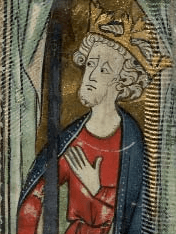
By the time Alexander III died, Clann Domhnaill owned lands like Kintyre, Islay, southern Jura, and likely Colonsay and Oronsay. Aonghus Mór is often called by his father's name. But his sons are usually called "of Islay." In 1292, the English king allowed Aonghus Mór and Alasdair Óg to travel and trade between Scotland and Ireland.
1292 is also when a violent feud between Clann Domhnaill and Clann Dubhghaill first appeared. This fighting seemed to start because Alasdair Óg married a woman from Clann Dubhghaill. The feud was probably about her land claims. Aonghus Mór, Alasdair Óg, and Alasdair Mac Dubhghaill promised King Edward I of England that they would stop the feud. They also promised to keep peace in the "isles and outlying territories." But the bitter family struggle continued through the 1290s.
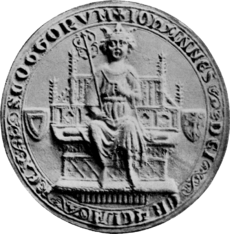
In February 1293, at the first parliament of John, King of Scotland, three new sheriffdoms were created in the west. William II, Earl of Ross became Sheriff of Skye in the north-west. His area covered lands once held by another family before 1266. In the central-west, Alasdair Mac Dubhghaill became Sheriff of Lorn, ruling much of Argyll. In the south-west, James Stewart became Sheriff of Kintyre. These new divisions clearly showed how the king's power was growing in the west since 1266.
It's interesting that no one from Clann Domhnaill attended the king's first parliament. A few days later, Alasdair Mac Dubhghaill, who was the king's main representative in the west, was ordered to bring Aonghus Mór and two other local landowners to pay homage to the king by Easter.
Aonghus Mór seems to have died around 1293. According to old stories from the Hebrides, he died on Islay. One source says he was buried on Iona. Alasdair Óg later renewed Aonghus Mór's gift of the church of St Ciarán. This suggests that Alasdair Óg had taken over by then. Alasdair Óg definitely became the leader of Clann Domhnaill by the mid-1290s.
Images for kids
-
An imaginative sixteenth-century illustration of Alexander III, King of Scotland, attending the parliament of his English counterpart, as depicted by the Wriothesley Garter Book.
See Also
- Clann Domhnaill
- Kingdom of the Isles
- Lord of Islay



